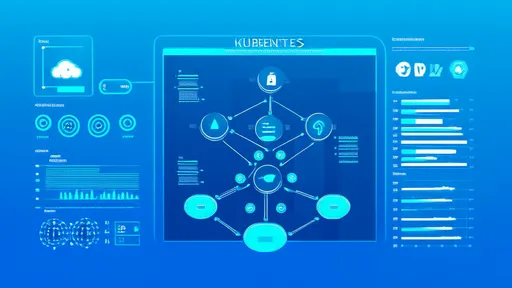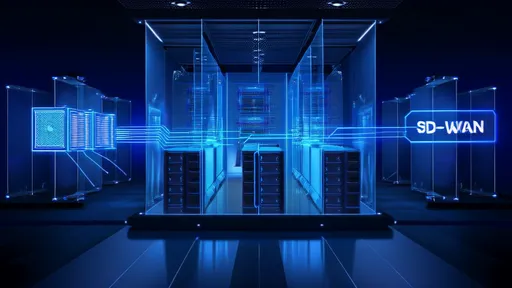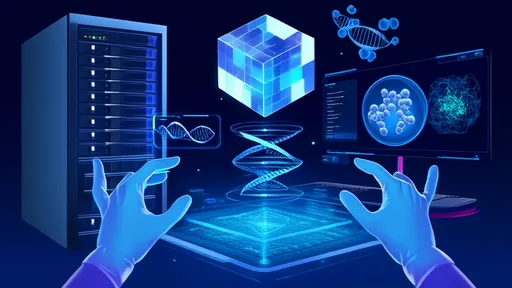The semiconductor industry stands at an inflection point where traditional chip design methodologies are increasingly strained by the complexity of modern architectures. As Moore's Law continues its relentless march, the once-manual processes of floorplanning and routing have become prohibitively time-consuming and error-prone. In this challenging landscape, reinforcement learning has emerged not merely as an experimental approach but as a transformative force in automating and optimizing chip layout.
Reinforcement learning operates on a fundamentally different paradigm than conventional algorithms. Unlike supervised learning that requires labeled datasets, RL agents learn through trial and error, receiving rewards for successful actions and penalties for failures. This makes it exceptionally well-suited for chip layout where the design space is enormous and optimal solutions are often counterintuitive even to experienced human designers. The technology doesn't just mimic human strategies—it discovers novel approaches that defy conventional wisdom.
The implementation process begins with the RL agent receiving a netlist—the digital blueprint of the chip's components and their interconnections. Through millions of simulated placements, the agent explores different configurations, gradually learning which arrangements minimize wirelength, reduce signal delays, and optimize power distribution. What makes this remarkable is that the system develops an intuitive understanding of physical design constraints without explicit programming for every possible scenario.
Recent breakthroughs have demonstrated RL's superiority over traditional approaches. In one notable case, Google reported that their reinforcement learning system completed complex chip layouts in under six hours—a task that typically takes human experts several weeks. The resulting designs showed significant improvements in performance, power efficiency, and area utilization. These aren't incremental gains but substantial leaps that directly impact the final product's competitiveness.
The learning architecture itself represents a marvel of engineering sophistication. Most systems employ deep reinforcement learning where neural networks approximate the value functions that guide decision-making. These networks process spatial representations of the chip canvas, learning to recognize patterns and relationships that human designers might overlook. The system develops what might be called design intuition—an ability to make sophisticated trade-offs between competing objectives.
What makes reinforcement learning particularly valuable is its adaptability to different design constraints and objectives. Whether optimizing for maximum clock speed, minimal power consumption, or specific thermal characteristics, the same underlying framework can be trained to prioritize different reward signals. This flexibility allows semiconductor companies to tailor the optimization process to their specific product requirements without developing entirely new algorithms for each design goal.
The training process represents both a technical challenge and strategic investment. Initial training requires substantial computational resources, often involving thousands of CPU hours across multiple servers. However, this upfront cost is rapidly justified by the dramatic reduction in design cycle time and improvement in results. Once trained, the same model can be adapted to similar chip families, creating a virtuous cycle of continuous improvement across multiple projects.
Critically, these systems don't operate in isolation from human designers. The most effective implementations combine RL's computational power with human expertise. Designers set overall constraints and objectives, then review and refine the AI-generated solutions. This collaboration leverages the strengths of both approaches: the machine's ability to explore countless possibilities rapidly, and the human's understanding of broader architectural considerations and real-world constraints.
The business implications extend beyond technical performance. By dramatically accelerating the design process, reinforcement learning enables faster time-to-market for new chips—a crucial advantage in competitive industries like mobile processors and AI accelerators. Companies can iterate more rapidly on designs, respond more quickly to market changes, and reduce development costs significantly. This technological advantage is becoming a strategic differentiator in the semiconductor industry.
Looking forward, the integration of reinforcement learning with other AI techniques promises even greater advancements. Combining RL with generative adversarial networks could produce entirely novel layout paradigms. Incorporating transfer learning will enable knowledge gained from previous designs to accelerate new projects. As these technologies mature, we're likely to see completely automated design flows that require minimal human intervention.
The evolution of this technology isn't without challenges. Ensuring that RL systems consistently produce manufacturable designs requires careful constraint formulation. The black-box nature of deep learning decisions sometimes makes it difficult to understand why particular layouts were chosen. Addressing these concerns through explainable AI techniques represents an important area of ongoing research.
Despite these challenges, the trajectory is clear. Reinforcement learning is fundamentally changing how chips are designed, moving the industry from computer-assisted design to AI-driven design. This shift represents more than just incremental improvement—it's transforming the very nature of semiconductor engineering. As the technology continues to mature, we can expect even more sophisticated applications that push the boundaries of what's possible in chip design.
The adoption curve follows a familiar pattern in technological disruption. Early adopters are already achieving significant advantages, while the broader industry is rapidly building competency. Within the next few years, RL-powered layout tools will likely become standard across the semiconductor industry, much like CAD tools did decades earlier. Companies that delay adoption risk being left behind in both capability and competitiveness.
What makes this development particularly exciting is its timing. As the industry faces increasing challenges with advanced process nodes below 5nm, traditional design methods are reaching their limits. Reinforcement learning arrives precisely when it's most needed—offering new approaches to problems that were becoming increasingly intractable. This synchronicity suggests we're witnessing not just an improvement in tools, but a necessary evolution in design methodology.
The implications extend beyond commercial applications. Academic researchers and open-source projects are making impressive strides with limited resources, demonstrating that the benefits of RL in chip design aren't limited to well-funded corporate labs. This democratization of advanced design capabilities could spur innovation across the industry, potentially leading to new architectural approaches and design philosophies.
As with any transformative technology, successful implementation requires more than just technical capability. Organizations must develop new workflows, train their engineers, and adapt their design processes. The companies that will benefit most are those that view this as an organizational transformation rather than merely a tool adoption. The human element remains crucial—even as the tools become increasingly autonomous.
In the broader context of AI advancement, the success of reinforcement learning in chip design represents a significant milestone. It demonstrates that AI can excel not just at pattern recognition but at complex optimization tasks requiring sophisticated spatial reasoning and long-term planning. This success likely previews similar transformations in other engineering domains where complex design optimization is required.
The future development path appears increasingly clear. We can expect continued refinement of RL algorithms specifically tuned for layout problems. Integration with other aspects of the design flow will create more comprehensive automated systems. And as the technology proves its value, investment will increase—accelerating the pace of improvement in a classic virtuous cycle of technological advancement.
For practicing chip designers, this represents both a challenge and an opportunity. The nature of their work is evolving from manual layout to guiding and supervising AI systems. This requires developing new skills in machine learning and data science while deepening their understanding of fundamental design principles. The most successful designers will be those who embrace this evolution and learn to leverage AI as a powerful collaborator.
Ultimately, the integration of reinforcement learning into chip design represents a perfect example of technology helping to solve the problems created by technological advancement. As chips become more complex, the tools to design them must become more sophisticated. Reinforcement learning isn't just keeping pace with this complexity—it's enabling the next generation of innovations that will power future technological progress across countless industries and applications.
In today's rapidly evolving cybersecurity landscape, organizations face increasingly sophisticated threats that traditional perimeter-based defenses struggle to contain. The concept of microsegmentation has emerged as a critical component of zero trust architecture, fundamentally transforming how enterprises protect their digital assets. Unlike conventional security approaches that focus on building strong outer walls, microsegmentation operates on the principle that no entity—whether inside or outside the network—should be automatically trusted.
In the ever-evolving landscape of container orchestration, Kubernetes has firmly established itself as the de facto standard for managing containerized applications at scale. One of its most powerful features is the ability to automatically scale applications in response to fluctuating demand, ensuring optimal performance while controlling costs. However, implementing an effective autoscaling strategy requires more than just enabling the feature; it demands a thoughtful approach grounded in proven best practices.
In today's digital landscape, cloud computing has become the backbone of modern business operations, offering unparalleled scalability and flexibility. However, this convenience comes at a cost—literally. As organizations increasingly migrate to the cloud, managing and controlling cloud expenditures has emerged as a critical challenge. Many companies find themselves grappling with unexpected bills, wasted resources, and a lack of visibility into where their cloud dollars are going. This is where FinOps, a cultural practice and operational framework, steps in to bring financial accountability to the world of cloud spending.
The cybersecurity landscape continues to evolve at a breakneck pace, with containerization sitting squarely at the heart of modern application development. As organizations increasingly deploy applications using technologies like Docker and Kubernetes, the security of the underlying container images has become a paramount concern. This has spurred the development and maturation of a robust market for container image vulnerability scanning tools, each promising to fortify the software supply chain. A comprehensive evaluation of these tools reveals a complex ecosystem where capabilities, integration depth, and operational efficiency vary significantly.
As enterprises continue their digital transformation journeys, the debate between SD-WAN and SASE for hybrid cloud connectivity has become increasingly prominent. These two technologies represent different generations of networking solutions, each with distinct approaches to addressing the complex challenges of modern distributed architectures. While SD-WAN emerged as a revolutionary improvement over traditional MPLS networks, SASE represents a more comprehensive framework that integrates networking and security into a unified cloud-native service.
The evolution of cloud-native databases has entered a new phase with the rise of serverless architectures. What began as a shift from on-premise data centers to cloud-hosted instances has now matured into a more dynamic, cost-efficient, and scalable paradigm. The serverless model represents a fundamental rethinking of how databases are provisioned, managed, and utilized, moving away from static resource allocation toward an on-demand, pay-per-use approach. This transformation is not merely a technical upgrade but a strategic enabler for businesses aiming to thrive in an unpredictable, data-intensive landscape.
In the rapidly evolving landscape of cloud-native computing, the demand for robust observability has never been more critical. As organizations migrate to dynamic, distributed architectures, traditional monitoring tools often fall short in providing the depth and real-time insights required to maintain system reliability and performance. Enter eBPF—extended Berkeley Packet Filter—a revolutionary technology that is redefining how we achieve observability in cloud-native environments. Originally designed for network packet filtering, eBPF has evolved into a powerful kernel-level tool that enables developers and operators to gain unprecedented visibility into their systems without modifying application code or restarting processes.
The landscape of enterprise IT has undergone a seismic shift with the widespread adoption of multi-cloud and hybrid cloud strategies. While this approach offers unparalleled flexibility, cost optimization, and avoids vendor lock-in, it introduces a formidable layer of complexity. At the heart of this complexity lies the significant challenge of managing compatibility across disparate cloud environments. Cross-cloud management platforms have emerged as the central nervous system for this new reality, but their effectiveness is directly tied to their ability to navigate a labyrinth of compatibility issues.
The economic implications of serverless computing have become a central topic in cloud architecture discussions, shifting the conversation from pure technical implementation to strategic financial optimization. As organizations increasingly adopt Function-as-a-Service (FaaS) platforms, understanding the nuanced cost structures and optimization opportunities has become critical for maintaining competitive advantage while controlling cloud expenditures.
The landscape of software development has undergone a seismic shift with the proliferation of cloud-native architectures. As organizations race to deliver applications faster and more reliably through CI/CD pipelines, a critical challenge has emerged: security. The traditional approach of bolting on security measures at the end of the development cycle is no longer tenable. It creates bottlenecks, delays releases, and often results in vulnerabilities being discovered too late, when remediation is most costly and disruptive. In response, a transformative strategy known as "shifting left" has gained significant traction, fundamentally rethinking how and when security is integrated into the software development lifecycle.
The landscape of software testing is undergoing a profound transformation, driven by the relentless integration of artificial intelligence. One of the most impactful and rapidly evolving applications of AI in this domain is the automation of test case generation. This is not merely an incremental improvement to existing processes; it represents a fundamental shift in how development teams approach quality assurance, promising to accelerate release cycles while simultaneously enhancing the robustness and coverage of testing regimens.
In the ever-evolving landscape of artificial intelligence, voice generation technology has emerged as one of the most captivating and, at times, unsettling advancements. The ability to clone and generate highly realistic human voices is no longer confined to the realms of science fiction; it is a present-day reality with profound implications. This technology, often referred to as voice cloning or neural voice synthesis, leverages deep learning models to analyze, replicate, and generate speech that is indistinguishable from that of a real person. The process begins with the collection of a sample of the target voice, which can be as short as a few seconds or as long as several hours, depending on the desired fidelity and the complexity of the model being used.
The semiconductor industry stands at an inflection point where traditional chip design methodologies are increasingly strained by the complexity of modern architectures. As Moore's Law continues its relentless march, the once-manual processes of floorplanning and routing have become prohibitively time-consuming and error-prone. In this challenging landscape, reinforcement learning has emerged not merely as an experimental approach but as a transformative force in automating and optimizing chip layout.
In laboratories and research institutions across the globe, a quiet revolution is underway as artificial intelligence becomes an indispensable partner in scientific discovery. What was once the domain of human intuition, years of trial and error, and painstaking data analysis is now being accelerated at an unprecedented pace by machine learning algorithms and computational power. This transformation is not about replacing scientists but empowering them to ask bigger questions and uncover deeper truths about our universe.
In the ever-evolving landscape of artificial intelligence, a quiet revolution is taking place that promises to fundamentally reshape how machines understand the world. For decades, the field has been dominated by correlation-based approaches—powerful pattern recognition systems that excel at finding statistical relationships in data but fall painfully short when it comes to true understanding. The emerging discipline of causal machine learning seeks to change this paradigm, moving beyond mere correlations to uncover the actual mechanisms that drive phenomena in the real world.














